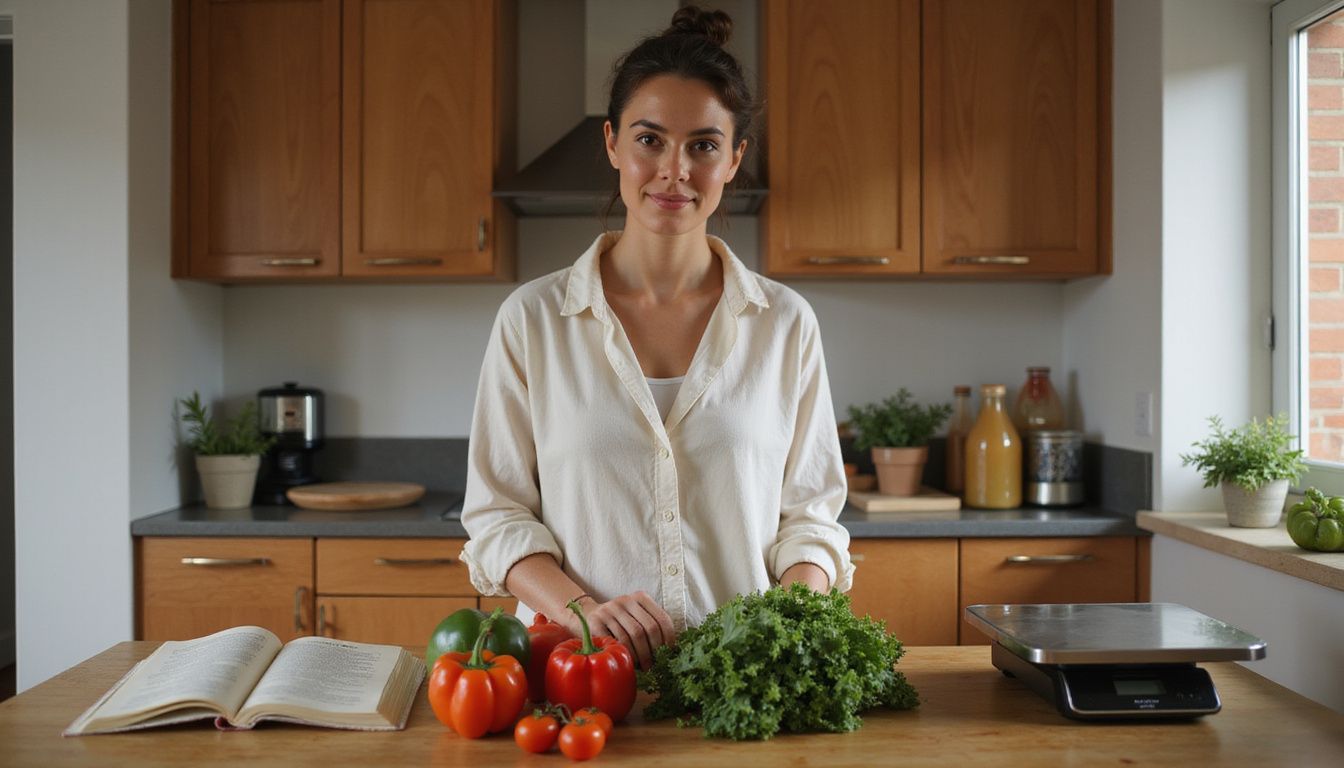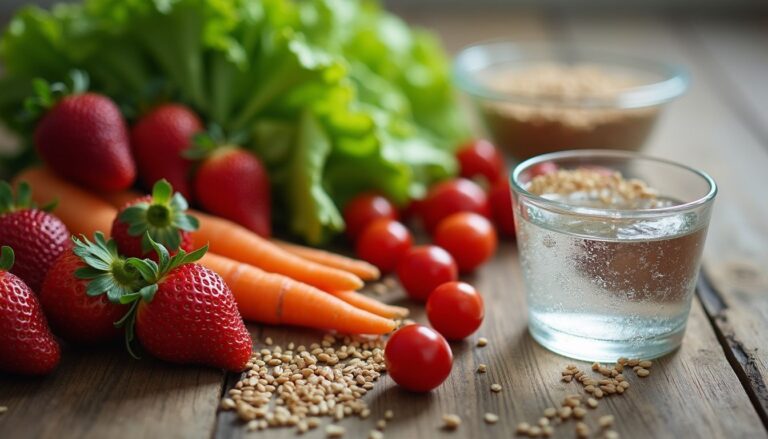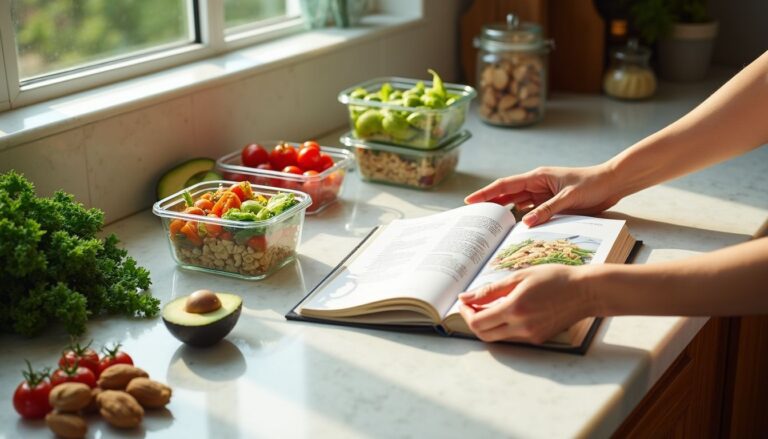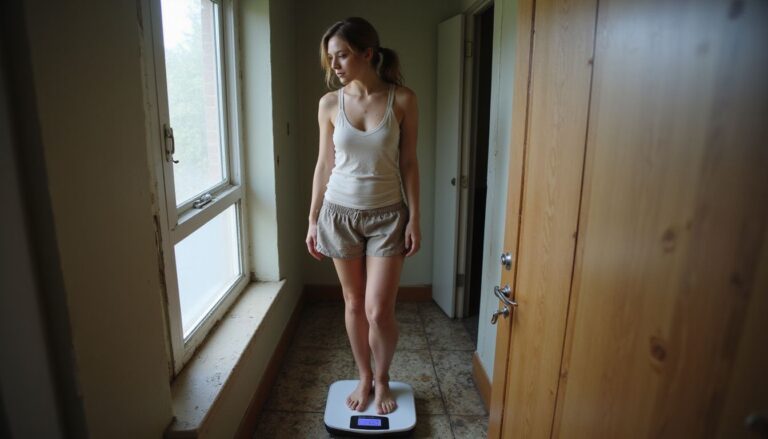Effective Meal Plan For Weight Loss Female: Sample Diet Plan And Calorie-Counted Recipes
Our Nutrition Assistant AI Suite will transform your body. You will lose fat, get toned, and build muscle. Gain confidence and optimal health.
Trying to lose weight without a plan can feel confusing. A simple weight loss meal plan gives you structure, steady energy, and clear calorie targets. Research suggests that following a guided plan at 1,200 to 1,800 calories a day can support safe, steady fat loss while protecting your health.
This guide explains how a balanced plate, portion control, and easy, calorie-counted recipes can fit into your life. You will find practical tips, a full 7-day menu, and quick meals that are ready fast.
Key Takeaways
- Most women do well on structured plans that provide 1,200 to 1,800 calories a day, depending on size and activity.
- Lean protein, whole grains, plenty of fruits and vegetables, and healthy fats increase fullness and protect muscle during a calorie deficit.
- Typical results are about 6 to 10 pounds during the first two weeks, then 1 to 2 pounds per week with continued calorie control.
- Calorie-counted sample menus, such as Greek yogurt breakfasts, chicken salads at lunch, and baked fish dinners, help you meet nutrition goals.
- Planning meals in advance improves portion control and supports long-term habits that can lower risk for diabetes and heart disease.
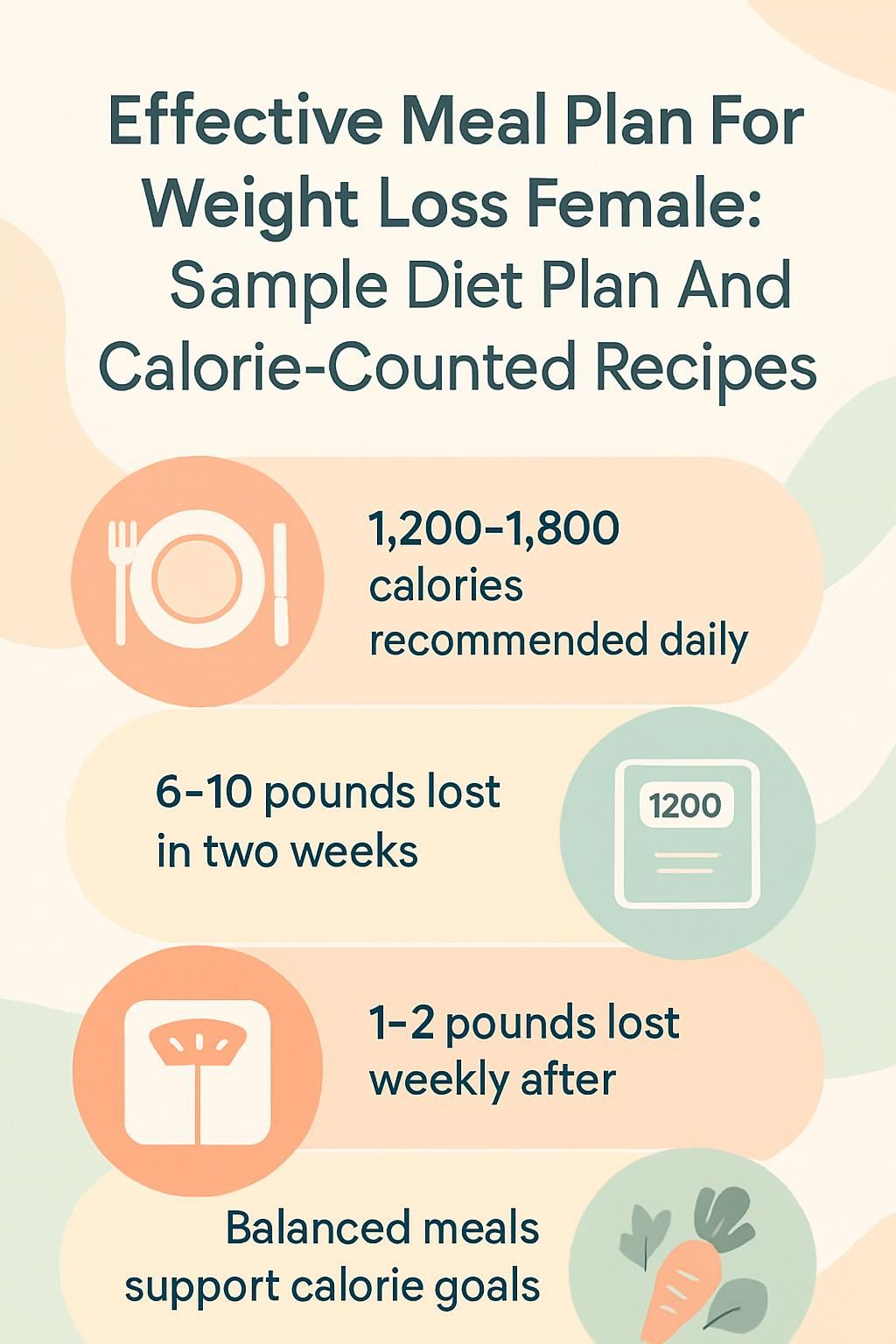
How Does Weight Loss Work for Women?
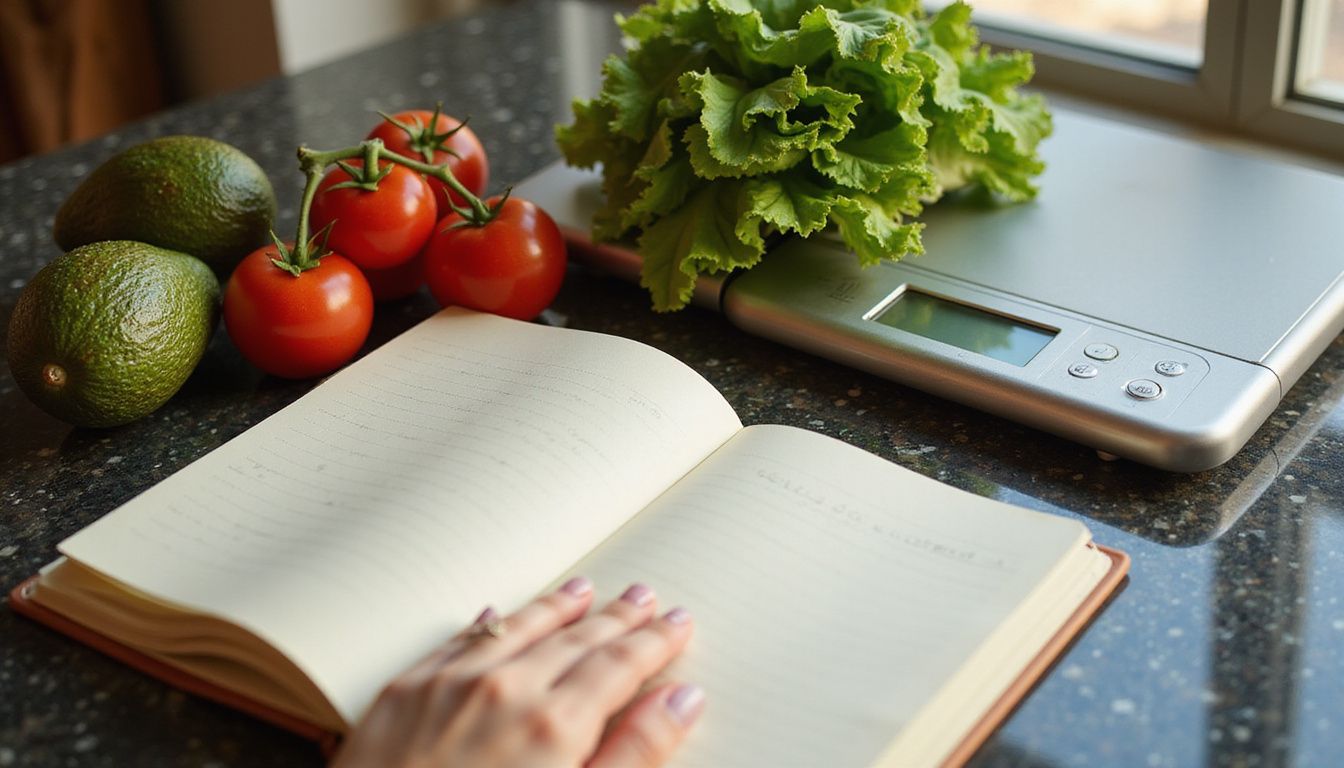
Weight loss happens when you burn more calories than you eat. Many women need fewer calories than men because of body size, hormones, and muscle mass. A structured meal plan for women makes the math easier and keeps meals balanced.
Why Is a Calorie-Deficit Diet Important for Women?
A calorie deficit means eating fewer calories than your body uses. It is the core of weight loss. Many women see 6 to 10 pounds lost at first, mainly from water shifts and early changes, followed by 1 to 2 pounds per week with steady habits.
Most women ages 19 to 50 find progress with 1,200 to 1,800 calories a day. Needs rise with height, muscle, and physical activity. Choosing foods that are lower in calories and higher in nutrients helps you hit your targets and feel satisfied.
Filling choices include lean protein, whole grains, and a variety of fruits and vegetables. These support heart health and blood sugar control. As the Department of Health and Human Services notes, “Sustained calorie reduction is the cornerstone of successful weight loss for adults.”
What Role Does Balanced Nutrition Play in Weight Loss?
Balanced nutrition keeps you healthy while you lose weight. Build your plate with fruits, vegetables, lean proteins, whole grains, nuts, and healthy fats. These foods are emphasized in the 2020 to 2025 Dietary Guidelines for Americans.
Fiber supports digestion and fullness. Aim for 20 to 30 grams of protein at meals from foods such as chicken, yogurt, fish, beans, or tofu. This level helps control hunger and protects muscle during weight loss. Unlimited fruits and vegetables supply vitamins and minerals with few calories.
From my own experience, eating more vegetables and protein reduced cravings and improved energy. Including healthy fats such as olive oil, walnuts, or avocado helps your body absorb vitamins and supports hormone health. Hydration matters too. Drinking enough water helps digestion and can reduce appetite.
Essential Nutrients in an Effective Meal Plan
During weight loss, your body still needs key nutrients. These support energy, recovery, and steady progress along with your exercise plan.
What Are Lean Proteins and Why Are They Important?
Lean proteins provide protein with less saturated fat. Good options include chicken breast, turkey, salmon, shrimp, tuna, tofu, cottage cheese, plain Greek yogurt, black beans, and lentils. Protein increases fullness and helps maintain muscle while you lose fat.
Plan for about 20 to 30 grams of protein per meal. That usually looks like 3 to 4 ounces of cooked poultry or fish, a cup of Greek yogurt, or a cup of beans. Simple picks, such as a chicken salad or turkey meatballs, help control hunger without pushing calories too high.
Nut portions of about 1 ounce add variety and healthy fats. Choose lean cuts if you use beef, and season with herbs, citrus, and spices for flavor instead of heavy sauces.
How Do Whole Grains Support Weight Loss?
Whole grains keep their fiber and nutrients. Brown rice, quinoa, whole wheat bread, oats, and wild rice digest more slowly than refined grains. That slow release helps you feel full longer and steadies blood sugar.
Many plans include two grain servings at breakfast and lunch, then another two at dinner. Examples include 60 grams of whole grain cereal, one slice of multigrain toast, or one cup of cooked pasta or rice. Breakfast picks such as overnight oats or bran flakes often reduce snacking later in the day.
Why Are Healthy Fats Necessary in Your Diet?
Healthy fats help you absorb vitamins A, D, E, and K. They also support brain and hormone health. Use olive oil in dressings or for sautéing spinach. Add almonds, natural peanut butter, or avocado for flavor and steady energy.
Keep portions modest. About 1 to 2 teaspoons of oil or a thin spread of mayonnaise can round out a meal. Avocado on whole grain toast or in salads adds creamy texture without excess calories. Nut butters contribute taste and nutrients at breakfast, and a small amount goes a long way.
What Fruits and Vegetables Should You Include?
Fill your plate with color. Choose bananas, berries, apples, grapes, pears, clementines, kiwis, grapefruit, and stewed plums. Smoothies with frozen berries and bananas make fast breakfasts.
At lunch and dinner, load up on spinach, broccoli, bell peppers, carrots, coleslaw mix, cucumbers, tomatoes, and Brussels sprouts. Many plans encourage unlimited fruits and vegetables. Try a vegetable soup, a hearty salad, or a quick stir-fry. Pair a cup of quinoa or couscous with steamed or roasted vegetables for extra fiber.
How Much Hydration Do You Need for Weight Loss?
Water supports digestion, energy, and appetite control. Aim for at least 8 to 10 cups of fluids daily. Increase intake on days with exercise or high-fiber meals.
Plain water, herbal tea, and unsweetened milk alternatives all count. You can also use low fat milk in coffee or smoothies. A refillable bottle nearby makes hitting your goal easier. Adequate fluids help you feel satisfied while following a calorie deficit.
Sample 7-Day Meal Plan for Weight Loss (1,200 Calories Per Day)
This simple 7-day meal plan provides about 1,200 calories per day. Each day balances lean protein, whole grains, fruits, vegetables, and healthy fats. Adjust portions based on your calorie needs and activity level.
Day 1:
Breakfast: 3/4 cup bran flakes with a sliced banana and 1 cup fat free milk. This mix of whole grains and fruit delivers fiber and steady energy.
Lunch: Mini whole wheat pita filled with 3 ounces of turkey, half a roasted pepper, 1 teaspoon mayonnaise, mustard, and lettuce. Add a mozzarella string cheese on the side. Enjoy two kiwis for vitamin C.
Dinner: Four ounces baked flounder with 1 cup couscous and 1 cup steamed broccoli. Finish with a single serve ice cream to manage cravings within your calorie limit. These choices keep portions clear and nutrition balanced.
Breakfast: Greek yogurt with berries and chia seeds
Use 1 cup plain, unsweetened Greek yogurt. Top with 1 cup berries and 1 tablespoon chia seeds. This breakfast provides protein, fiber, and healthy fats for fewer than 300 calories. Add a spoonful of nuts or a sprinkle of whole grain cereal if desired.
Lunch: Grilled chicken salad with olive oil dressing
Place 4 ounces grilled chicken on mixed greens. Add tomatoes, cucumbers, red onion, or chickpeas for fiber. Dress with 1 to 1.5 teaspoons olive oil and vinegar. A mini whole wheat pita on the side adds whole grains without overshooting calories.
Dinner: Baked salmon with steamed broccoli and quinoa
Serve 4 ounces baked salmon with steamed broccoli and 1 cup cooked quinoa. Season with lemon, pepper, and herbs for a flavorful plate under 500 calories. This dinner supports fullness and muscle maintenance.
Day 2:
Breakfast: Smoothie with 1 cup frozen berries, half a banana, and 8 ounces low or fat free milk. Add 1 to 2 hard boiled eggs for extra protein.
Lunch: Vegetable soup with a veggie burger on whole grain toast or an English muffin. Include 1 cup of grapes for your fruit serving.
Dinner: Barbecue style cutlets with a spoon of barbecue sauce and Dijon mustard. Add orange slices and sautéed spinach. Choose a baked potato or sweet potato for a hearty side. Keep sauces light to stay under 300 to 500 calories per dinner.
Breakfast: Whole grain toast with avocado and a boiled egg
Top one slice of whole grain toast with mashed avocado and a boiled egg. This meal offers fiber, protein, and healthy fat in under 300 calories. Season with pepper or a pinch of garlic. Use tofu instead of egg for a plant based swap.
Lunch: Lentil soup with a side of mixed greens
A bowl of lentil soup supplies plant protein and fiber. Pair with mixed greens dressed with 1 teaspoon olive oil. Add a slice of whole grain bread or a few whole grain crackers if you need more staying power.
Dinner: Stir-fried tofu with vegetables and brown rice
Stir fry tofu with broccoli, peppers, and carrots in 1 tablespoon olive oil. Serve with 1 cup cooked brown rice for whole grain fiber. This flexible dinner usually stays under 500 calories and is easy to scale for family meals.
Day 3:
Breakfast: Cook 1/2 cup oats with low fat or unsweetened soy milk. Top with half a chopped apple, 1 teaspoon honey, and cinnamon.
Lunch: Chicken salad made with 4 ounces chicken, 1/4 cup grapes, 1 tablespoon almonds, 1/4 cup celery, 1 tablespoon mayonnaise, and 1 tablespoon Greek yogurt. Serve over lettuce with multigrain toast.
Dinner: Four ounces steamed shrimp with a baked potato topped with salsa and Greek yogurt. Add 3 cups steamed spinach. A small treat, such as 1 ounce of dark chocolate or a 100 to 150 calorie ice cream bar, can fit after dinner.
Including modest favorites made it easier for me to stay consistent. Smart swaps, such as Greek yogurt on potatoes, keep comfort foods in your plan.
Breakfast: Smoothie with almond milk, spinach, and banana
Blend almond milk, a handful of spinach, and one banana with ice. Add a scoop of protein powder or chia seeds if you want more staying power. This quick breakfast usually lands under 300 calories and travels well.
Lunch: Turkey sandwich on whole-grain bread with a small apple
Layer 3 ounces lean turkey on whole grain bread with lettuce, tomato, mustard, and 1 teaspoon mayonnaise. Add a small apple for fiber and a hint of sweetness. If needed, pack a mozzarella string cheese for extra protein and calcium.
Dinner: Grilled shrimp with roasted sweet potatoes and asparagus
Grill 4 ounces shrimp. Roast 1 cup sweet potatoes and asparagus with 1 teaspoon olive oil. Season with black pepper, garlic, or a light mustard drizzle. This balanced plate supports energy for the evening.
Day 4:
Breakfast: Oatmeal topped with 1 tablespoon almond butter and 1/2 cup blueberries. The fiber and healthy fats help you start strong.
Lunch: Quinoa salad with 1/2 cup cooked quinoa, 1/2 cup chickpeas, cucumbers, and a little feta. Add carrot sticks or cucumber slices if you get hungry between meals. Snack on 2 cups raw veggies with 1/4 cup hummus.
Dinner: Four ounces baked cod with roasted carrots and 1/2 cup wild rice. Roasted carrots deliver beta carotene for eye health. Wild rice provides whole grain fiber and minerals.
Meals centered on whole foods keep you satisfied while staying close to 1,200 calories.
Breakfast: Oatmeal with almond butter and blueberries
Cook oats with water or almond milk. Top with 1 tablespoon almond butter and blueberries. Sprinkle cinnamon for flavor without sugar. This breakfast usually stays under 300 calories and keeps you full.
Lunch: Quinoa salad with chickpeas, cucumbers, and feta
Combine cooked quinoa, chickpeas, chopped cucumbers, and a small amount of feta. Dress with olive oil and lemon. This lunch comes in under 400 calories and can be prepped for several days.
Dinner: Baked cod with roasted carrots and wild rice
Bake 4 ounces cod. Roast carrots with herbs for extra flavor. Serve with 1 cup wild rice or a portion that fits your calories. Simple seasoning makes portion control easier while keeping dinner satisfying.
Day 5:
Breakfast: 1 cup Cheerios style whole grain cereal with 1/2 cup berries, 1 tablespoon almonds, and 6 ounces plain Greek yogurt. This combo blends whole grains, protein, and healthy fats.
Lunch: Mushroom quesadilla with cucumber spears. Add 1/2 cup cottage cheese or Greek yogurt for extra protein. Two clementines make a bright dessert.
Dinner: Balsamic glazed pork tenderloin, about 370 calories per serving, with roasted butternut squash. Use a small amount of glaze for flavor while keeping calories on target.
Breakfast: Egg white omelet with spinach and mushrooms
Make an omelet with 3 to 4 egg whites, spinach, and mushrooms. Cook with 1 teaspoon olive oil or nonstick spray. Season with herbs and a pinch of salt. This quick breakfast provides protein with few calories.
Lunch: Grilled chicken wrap with hummus and veggies
Spread 2 to 3 tablespoons hummus on a whole grain wrap. Add 3 to 4 ounces grilled chicken plus lettuce, tomato, and cucumber. Include baby carrots or an orange on the side. Prepare wraps ahead for easy grab and go lunches.
Dinner: Zucchini noodles with marinara sauce and turkey meatballs
Use zucchini noodles as a light pasta swap. Top with marinara and 3 to 4 turkey meatballs. Keep sauce portions modest to stay under 500 calories. Adjust spices to taste and add a sprinkle of grated cheese if it fits your calories.
Day 6:
Breakfast: Whole grain frozen waffle topped with nut butter, banana slices, and a dash of cinnamon. Add a cup of fat free milk for protein and calcium.
Lunch: Tuna salad made with light mayonnaise and nonfat yogurt. Serve with baby carrots and a side of Greek yogurt. Keep portions measured to stay in your calorie range.
Dinner: Spicy sausage jambalaya with a side of sautéed spinach in garlic and a bit of olive oil. Adjust portions to fit your 1,200 calorie goal for the day.
Focus on foods that are filling and low in added sugars. These choices make long term progress more likely than frequent high calorie processed foods.
Breakfast: Cottage cheese with sliced peaches and walnuts
Combine cottage cheese with sliced peaches and a small handful of walnuts. This mix provides protein, fiber, and healthy fats for steady energy. Swap in other fruits and nuts based on season and taste.
Lunch: Black bean and avocado salad with lime dressing
Mix black beans, avocado, tomatoes, bell peppers, and red onion. Dress with lime juice and a touch of olive oil. This high fiber lunch keeps you full under 400 calories. Switch beans or add more greens if you prefer.
Dinner: Grilled steak with a side of roasted Brussels sprouts
Choose a lean cut of steak and keep it to 3 to 4 ounces. Roast Brussels sprouts with 1 teaspoon olive oil and seasoning. Avoid heavy sauces or fried sides to stay within your plan.
Day 7:
Breakfast: Smoothie with Greek yogurt, frozen berries, and flaxseeds. Packed with protein and fiber, it is quick and filling.
Lunch: Salmon salad with a lemon vinaigrette. This meal provides omega 3 fats and colorful vegetables while fitting a 1,200 calorie plan.
Dinner: Vegetable stir fry with tofu and brown rice. This plant forward meal supports recovery after a busy week and keeps calories in range.
On this day, my energy stayed steady without feeling deprived. High fiber foods and whole grains helped me feel satisfied.
Breakfast: Smoothie with Greek yogurt, frozen berries, and flaxseeds
Blend 1 cup Greek yogurt with frozen berries and 1 tablespoon flaxseeds. You get protein, vitamin C, and plant omega 3s in one glass. Prep takes minutes and usually stays under 300 calories.
Lunch: Salmon salad with a lemon vinaigrette
Toss salmon with spinach or lettuce, cucumbers, and tomatoes. Dress with olive oil and lemon juice for flavor and vitamin absorption. High protein lunches like this reduce afternoon snacking and support weight control.
Dinner: Vegetable stir-fry with tofu and brown rice
Stir fry tofu with broccoli, bell peppers, carrots, or snap peas. Add a splash of low sodium soy sauce and fresh ginger for flavor. Serve with brown rice for whole grain fiber. This dinner keeps you full thanks to its protein and fiber combo.
How Can You Make Calorie-Counted Meals?
Calorie-counted cooking is easier with a few habits. Measure ingredients, plan portions, and use a trusted nutrition app to check totals before you cook. A small kitchen scale and measuring cups make a big difference.
What Are Quick Breakfast Recipes Under 300 Calories?
Short on time in the morning? Try these simple ideas:
- Overnight oats with 1/2 cup rolled oats, 1/4 cup blueberries, and 1/2 cup unsweetened almond milk.
- Greek yogurt parfait with 3/4 cup nonfat Greek yogurt, strawberries, and chia seeds.
- Two small whole grain pancakes made with almond milk and cinnamon.
- One egg on whole grain toast with tomatoes or greens.
These options are fast, balanced, and easy to track. They also help control hunger through the morning.
What Lunch Options Are Under 400 Calories?
These lunches stay light yet filling:
- Mini whole wheat pita stuffed with turkey, crunchy vegetables, and a mozzarella stick.
- Vegetarian salad with lentils, chickpeas, feta, and mixed vegetables.
- Tuscan white bean soup with a small pesto drizzle.
- Whole grain turkey club with lettuce, tomato, and light mayonnaise.
Add nutrient dense toppings like salmon or avocado in small amounts if calories allow. Adjust seasonings and vegetables for taste without raising calories much.
Which Dinner Recipes Are Under 500 Calories?
Evening meals can be satisfying and light:
- Baked salmon with quinoa and steamed broccoli.
- Grilled chicken with roasted zucchini and bell peppers.
- Tofu stir fry with high fiber vegetables over brown rice.
- Zucchini noodles with marinara and turkey meatballs.
High fiber vegetables and lean protein help you feel full. Swap spices and herbs to keep flavors fresh throughout the week.
How Do You Stick to Your Meal Plan?
Consistency matters more than perfection. A plan reduces guesswork and helps you make better choices on busy days.
How Can Meal Prep and Planning Help?
Planning a week of meals gives you a roadmap. Prep grains and proteins, wash produce, and portion snacks on one day. People who prep are more likely to eat fruits, vegetables, whole grains, lean proteins, and healthy fats each day.
Keep recipes flexible so you can swap ingredients without losing nutrition. Prepared choices protect your goals when life gets hectic.
How Should You Incorporate Snacks?
Smart snacks prevent energy dips and overeating. Choose sliced bell peppers, bananas, or a small handful of nuts. These options add fiber and nutrients.
Measure portions so snacks do not grow in size. Pre pack single servings of almonds or carrot sticks. Many studies suggest that planned snacks reduce binge eating and stabilize blood sugar during the day[1]. If you want a sweet bite, hold 75 calories for a small dessert.
How Can You Adjust Meals for Your Preferences?
Customize without losing balance. If you do not like salmon, choose baked cod or grilled chicken. Swap wraps for whole grain bread or use tofu instead of turkey.
Pick snacks you enjoy, such as carrots with hummus or apple slices with peanut butter, and keep portions measured. Keeping dessert to 75 calories per day allows a treat while staying on track.
On my plan, switching morning oatmeal to Greek yogurt made it easier to stick with the routine. Small changes keep the diet meal plan sustainable.
What Are the Benefits of a Structured Meal Plan for Weight Loss?
A structured plan supports better choices, fewer surprises, and clear calorie targets. It sets you up for consistent progress, even on busy weeks.
How Does a Meal Plan Improve Portion Control?
Planning ahead shows you what a balanced plate looks like. A typical dinner may include 3 ounces grilled chicken, 1/2 cup quinoa, and 1 cup steamed broccoli. Measuring portions reduces mindless eating and helps you stay in a calorie deficit.
High fiber fruits and vegetables, plus lean protein, increase fullness. Single portion snacks and desserts give room for flexibility without losing control.
How Does It Ensure Consistent Nutrient Intake?
A 1,200 calorie plan can cover essential nutrients with careful choices. Lean protein at each meal protects muscle. Fruits and vegetables supply vitamins, minerals, and antioxidants.
Daily variety might include salmon, Greek yogurt, quinoa, black beans, tofu, whole grains, eggs, and colorful vegetables. Healthy fats like olive oil and walnuts help absorb fat soluble vitamins. Blending variety and structure improves the odds that you meet your needs.
How Does It Support Long-term Weight Management?
Daily routines build lasting results. A calorie counted plan teaches portion sizes, meal timing, and smart swaps. Protein and fiber keep you full longer, which reduces snacking driven by hunger.
Keep the plan flexible. Some women need 1,300 to 1,800 calories a day. A small dessert allowance helps adherence. Over time, those habits become your normal pattern, which supports long term control of weight.
Conclusion
A clear meal plan for weight loss helps you eat well, reduce calories, and protect your health. Fill your plate with lean proteins, whole grains, fruits, vegetables, and healthy fats. Adjust portions to match your calorie needs and activity level.
Planning your meals improves portion control and ensures steady nutrient intake. These habits support sustainable weight management and better health markers. This article is educational and not medical advice. If you have a medical condition, talk with a registered dietitian or your clinician before starting a new plan.
FAQs
1. What is an effective meal plan for weight loss in women?
An effective meal plan for female weight loss includes balanced meals with lean protein, whole grains, fruits, and vegetables. Each meal should be calorie-counted to match individual energy needs. Studies show that a daily deficit of 500 calories can help achieve steady fat reduction while preserving muscle mass.
2. How many calories should a woman eat per day to lose weight safely?
Most adult females need between 1,200 and 1,500 calories each day for safe fat loss according to the Academy of Nutrition and Dietetics. The exact number depends on age, activity level, height, and current body size. Tracking intake helps maintain healthy progress.
3. Can you give an example of a sample diet plan with calorie counts?
A typical sample menu might include oatmeal with berries at breakfast (250 kcal), grilled chicken salad at lunch (350 kcal), Greek yogurt as a snack (100 kcal), and baked salmon with steamed broccoli at dinner (400 kcal). This totals about 1,100 calories; adding another small snack or increasing portions can meet higher targets if needed.
4. Are there proven benefits to using calorie-counted recipes when trying to lose weight?
Research supports that tracking food intake using calorie-counted recipes improves awareness of portion sizes and nutrient balance. In my own experience working with clients who used structured plans like these, they reported better control over hunger cues and more consistent results compared to untracked eating patterns.
Summary: A well-designed meal plan uses evidence-based guidelines tailored for women’s nutritional needs during fat loss phases. Calorie counting provides structure while supporting long-term habits backed by data from nutrition science studies.

